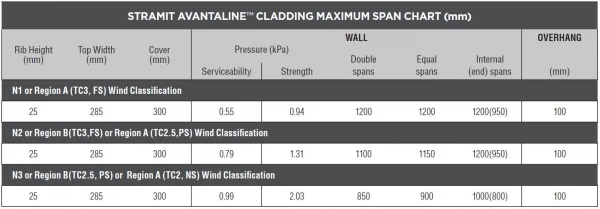Mitten Vinyl Australia Is An Official Stockist Of Stramit’s AvantaLine® Architectural Wall Cladding
Features and Benefits
- Creates a sleek, contemporary look
- Available in 25mm height
- All panels have a 15mm groove joint between them through which fasteners are installed
- Available in standard and matt COLORBOND® colours, as well as ZINCALUME® steel and Unicote® Lux
- Manufactured from non-combustible materials
- Fully tested and NCC compliant with a full range of load performance data tables to suit most applications.
Colour Options and Finishes
Base Material Thickness (mm): 0.55
Finish: COLORBOND®, ZINCALUME®, UniCote® Lux
Standard Steel
Ultra Steel
Matt Steel
Certain colour options and finishes may be subject to availability and lead times may vary from site to site. Other colours may be available, subject to minimum order quantities and additional lead times. Please contact your local Stramit office to confirm.
Buy At Mitten Vinyl Australia
Get the AvantaLine™ Architectural Cladding at Mitten Vinyl Australia, we are Stramit's official stockists. Simply fill in your requirements in the below form and we will be in touch with you.
Availability
This product is produced in NSW and is available in VIC, NSW and South East QLD. Availability and lead times may vary depending on your location.
General Information
AvantaLine® wall cladding will give excellent durability in almost all locations. It is however important to choose the correct coating for each application environment as shown in the table below. Durability recommendations do vary based on the application of the product, in walling installations. Please read the table below carefully.
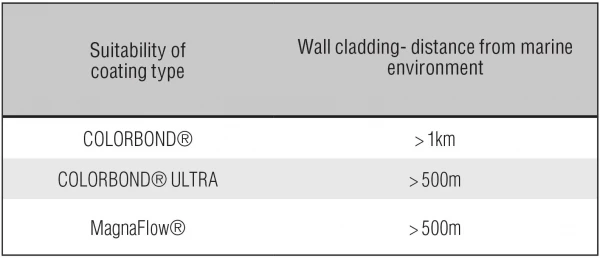
The suitability and exposure table above is current at the time of publication and is a guideline only; conditions will vary from site to site. Please check the BlueScope Technical Bulletins at www.bluescopesteel.com.au for the latest information and guidance on selection, maintenance and durability. If uncertain about the appropriate coating for a particular application, or if the product is to be used in environments affected by industrial emissions, fossil fuel combustion, animal farming, or has unwashed areas, please contact your nearest Stramit office for advice.
All building products need to be checked for compatibility with adjacent materials. These checks need to be for both direct contact between materials, and where water runs from one material to another.
The following guidelines generally avoid material incompatibility:
- For zinc-aluminium alloy coated steel, colour coated steel and galvanised steel cladding avoid copper, lead, green or treated timber, stainless steel and mortar or concrete.
- Galvanised steel sheets should not receive drainage from aluminium or any inert materials, such as plastics, glass, glazed tiles, colour coated and zinc-aluminium alloy.
Stramit’s roofing and walling products should be handled with care at all times to preserve the product capabilities and quality of the finish.
Packs should always be kept dry and stored above ground level while on site. If the products become wet, they should be separated, wiped and placed in the open to promote drying.
AvantaLine® cladding is suitable for use with insulating blanket. Glasswool blanket up to 50mm thick can be readily used. Increased thicknesses require longer fasteners and greater care in installation. Ensure the length of the screw is sufficient to have a minimum of 3 threads protruding below the support. For domestic applications Stramit recommends that insulation is always used.
AvantaLine® cladding is supplied cut-to-length. When designing or transporting long products ensure that the length is within the limit of the local Transport Authority regulations. The manufacturing tolerance on the length of product supplied is +0, -15mm.
Stramit products conform to the following Australian standards that are called up in the NCC.
Steel material
- All metallic coated steel complies with AS 1397
- Painted steel product conforms with AS 2728
Roofing / Walling products
- Roofing/walling profiles conform with AS 1562.1, and AS 4040 parts 0, 1, 2 and 3.
- Corrugated roofing conforms with AS 1445
- Wind Load data conforms to AS 1170 part 2, and/or AS 4055
- Fasteners conform with AS 3566
- Installation details are in accordance with the Standards Australia Handbook HB39
Stramit’s roofing and walling products are protected in Australia by registered designs.
All Stramit roofing and wall cladding products conform with, or are equivalent to, AS1562.1.
Stramit has in-house, purpose built testing equipment used to design, develop and improve products for the Australian market. Many of our products are tested or witnessed by independent organisations. These include:
- University of Technology, Sydney
- Cyclone Testing Station (James Cook University)
- The University of Sydney, and
- CSIRO.
The ongoing research and development activity ensure we remain at the forefront of innovation, design and consumer information.
Technical Information
Please refer to the Stramit Roof and Wall Flashing Architectural Detailing Design Guide.
The walling shall be 0.55mm BMT Stramit AvantaLine® cladding in continuous lengths with 25mm high ribs and flat tops spaced at specified centres to suit fixing methods.
Sheeting material shall be protected steel sheet to Australian Standard AS1397, with a minimum yield stress of 300MPa (Grade G300) and an AM100/AZ150 coating with an oven-baked paint film of selected colour, or a plain AM125/AZ150 coating.
The sheeting shall be fixed to the girts/battens in accordance with the manufacturer’s recommendations. Suitable fixing screws in accordance with Australian Standard AS3566, Class 3, shall be used at every support.
Sheets shall be laid in such a manner that the approved side lap faces away from the prevailing weather.
Flashings shall be supplied in compatible materials as specified; minimum cover of flashing shall be 150mm.
All sheeting shall be fixed in a workman-like manner, leaving the job clean and weathertight.
All debris (nuts, screws, cuttings, filings etc.) shall be cleaned off daily.
A NATSPEC work section is available for this product. Download
All fasteners with Phillips head.
One screw at each edge and lap through both layers of material per support:
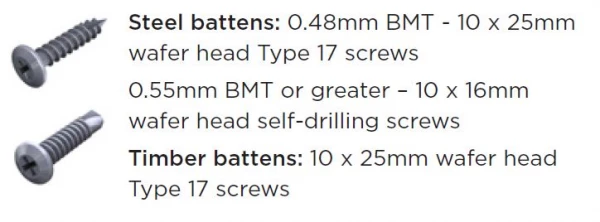
Fire resistance is such an important topic and one that we take seriously at Stramit.
Stramit® roofing, cladding, rainwater and structural building products are manufactured from steel produced by BlueScope® Steel or Pacific Coil Coaters (through Selection Steel). Both organisations have had independent tests on their materials carried out by CSIRO or AWTA. The testing was conducted in accordance with the Australian Standard AS1530.3 ‘Simultaneous Determination of Ignitability, Flame Propagation, Heat Release and Smoke Release.’ All materials had a surface finish less than 1mm in thickness and a Spread of Flame Index of 0. When tested to AS5637.1, Bluescope® COLORBOND® Steel has a Product Group Number classification of 1.
Stramit® products made from these steel sources and with the tested finishes would be considered non-combustible according to NCC 2019 Volume One Part C1.9(e) and Volume Two Part 3.7.1.1.
It is important to note that Stramit® sheeting is only one component used in construction of these building elements, and other components must also meet the necessary requirements to satisfy the criteria.
For more information, refer to the Stramit Flammability Guide.
Stramit’s AvantaLine® cladding is manufactured from G300 colour coated steel, aluminium-zinc-magnesium or zinc-aluminium alloy coated steel. In some locations severe environment colour-coated steel may be available by arrangement.
Colour-coated steels are in accordance with AS/NZS2728 – Category 3 and, for the substrate, with AS1397. Aluminium-zinc-magnesium alloy coated AM100/AM125, zinc-aluminium alloy coated AZ150 conforms to AS1397.
Stramit has a comprehensive range of colours as standard. Ask your nearest Stramit location for colour availability.
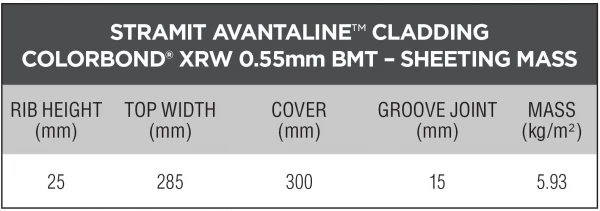
Wide, flat profiles may be subject to “oil canning”, a perceived waviness in the material. This may happen in any wide, flat profiles and is usually an aesthetic issue only and the structural performance is not affected.
Since many uncontrollable factors are involved, no manufacturer can realistically assure the total elimination of oil canning.
With careful attention to the production and selection of material, to the panel design and to installation practice, oil canning can be effectively minimised.
To minimise the appearance of oil canning, use narrower profiles, lighter colours in matt finishes, ensure the sub structure is in a flat plane and fasteners are installed correctly.
Stramit tests to Australian Standard AS1562.1 called up in the National Construction Code to provide span load tables.
The spans shown below are based on the direct pressure testing method described in the current version of AS1562.1 and take account of wind resistance including local pressure zone effects.
Pressures are based on AS4055 or AS1170.2. Where the two standards differ, the worst case has been taken for each classification.
Data should only be used for buildings 7m or less in height, 1000m2 or less in area, where both length and width exceed the building height and site is unaffected by land topography.
Designs for the most popular profiles are shown below.
Stramit’s AvantaLine® cladding is not suitable for spring curving applications. It is most important that the structure behind the AvantaLine® cladding is the one flat plane, so any installation distortions are reduced.
Stramit tests to Australian Standard AS1562.1 called up in the National Construction Code to provide wind pressure tables.
The table below shows wind pressure capacity based on the direct pressure (airbox) test method.
Tables are based on testing to AS1562.1 and AS4040 parts 0 and 2. Internal spans must have both end spans 20% shorter.
Design Information
Sheet length for design purposes
AvantaLine® cladding standard production maximum length is 9 metres. Longer lengths may be available however are not standard and should be discussed with Stramit before designing. Due to the nature of the interlocking profile, additional care must be taken when manufacturing, handling and transporting long lengths. It’s recommended that designs are made within the current standard lengths.
Installation Information
Stramit’s cladding can be easily cut, where required, using a power saw with a cold cut saw blade or a power nibbler and, for localised cutting, tin snips. Avoid the use of abrasive discs as these can cause burred edges and coating damage. Please dispose of any off-cuts carefully and thoughtfully.
End lapping of AvantaLine® cladding is not recommended. Contact Stramit Technical Services for more information.
AvantaLine® direct fix cladding has the fasteners driven through both layers of each lap joint, shown as double skin fixing below.
1. Ensure all purlins/battens are in line and correctly installed and that building wrap, plywood substrate, mesh and blanket (if specified) are in place. Note plywood substrate may not be accepted in bushfire prone areas.
2. Position the first sheet ensuring correct overhangs and fix the trailing edge to each support using the nominated fastener. Ensure screws are not over tightened.
3. Carefully insert the trailing edge of the next sheet into the groove in the leading edge of the former sheet. Ensure a uniform gap of 15mm is maintained between the vertical upstands of the two sheets by using spacers or similar. Any variation in the gap will be visible, care must be taken to ensure it is uniform.
4. Fix the two sheets down with a single screw at each support, ensuring both layers are fixed down as indicated in double skin fixing diagram.
5. Continue to install subsequent sheets checking that the sheet ends are aligned and the 15mm gap between the sheet upstands is maintained.
6. Measure the overall cover width at the top and bottom of the sheets from time to time to avoid “fanning”.
7. Install flashings as necessary to ensure watertight solution.
8. Clean up after each day’s work, removing all screws, cuttings, swarf etc and leave area clean.
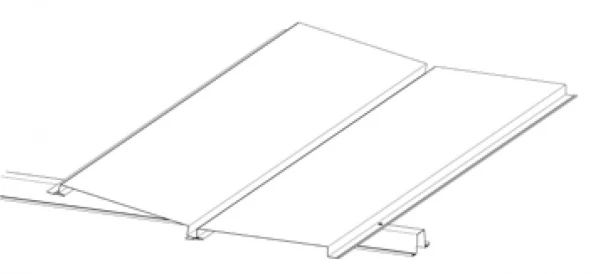
See below for typical corner flashing detail.
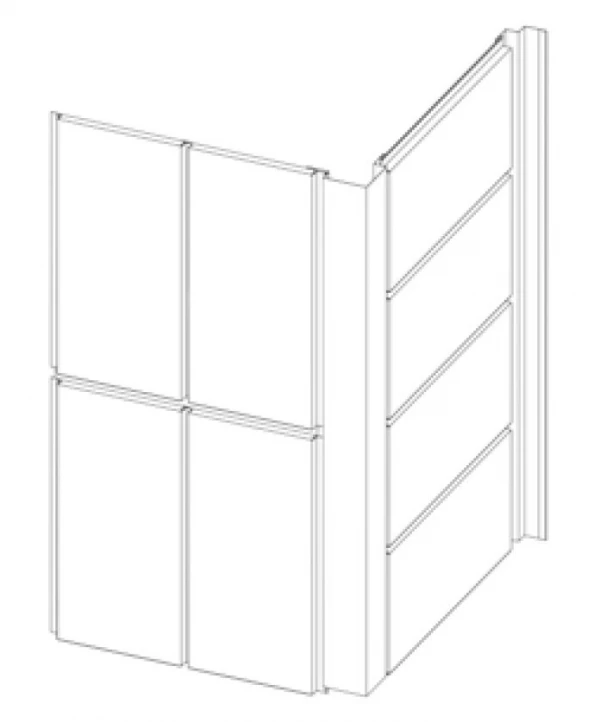
For more flashing detail, refer to the Stramit® Roof and Wall Flashing Architectural Detailing Design Guide.
Maintenance Information
Care & Maintenance
Below are some handy hints and tips to achieve maximum life from your COLORBOND® and ZINCALUME® finished products.
- In areas of little rainfall, products should be cleaned regularly.
- Brick cleaning acid should not come into contact with steel fascia, gutter, or roofing and walling.
- Never immerse these products in sand, soil or concrete.
- Do not use touch up spray can paint on COLORBOND® steel.
- Remove metal debris from cutting and/or drilling to avoid swarf damage.
- Prior to installation, keep bundled material dry.
- Prepainted metal roofing components should be stored in the shade as the protective plastic film will become difficult to remove if it is exposed to direct sunlight.
- Make sure materials made of different metal, such as copper and lead, do not make contact with these products, and water does not run from one to the other.
- Roofing and guttering should be free draining and free from dirt and leaves.


